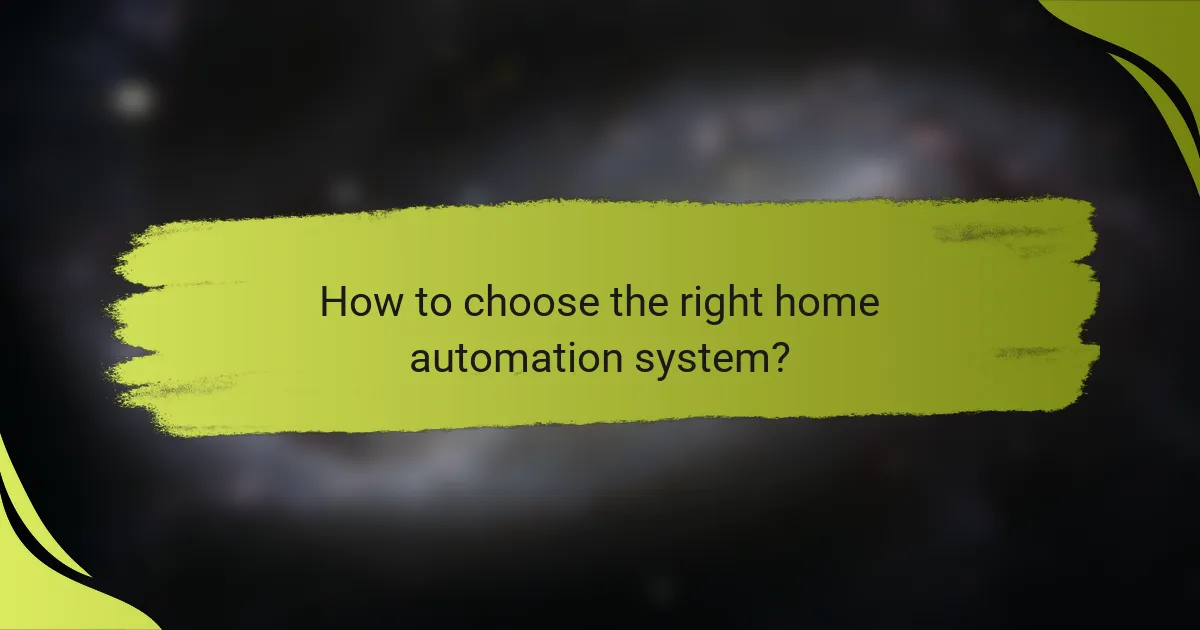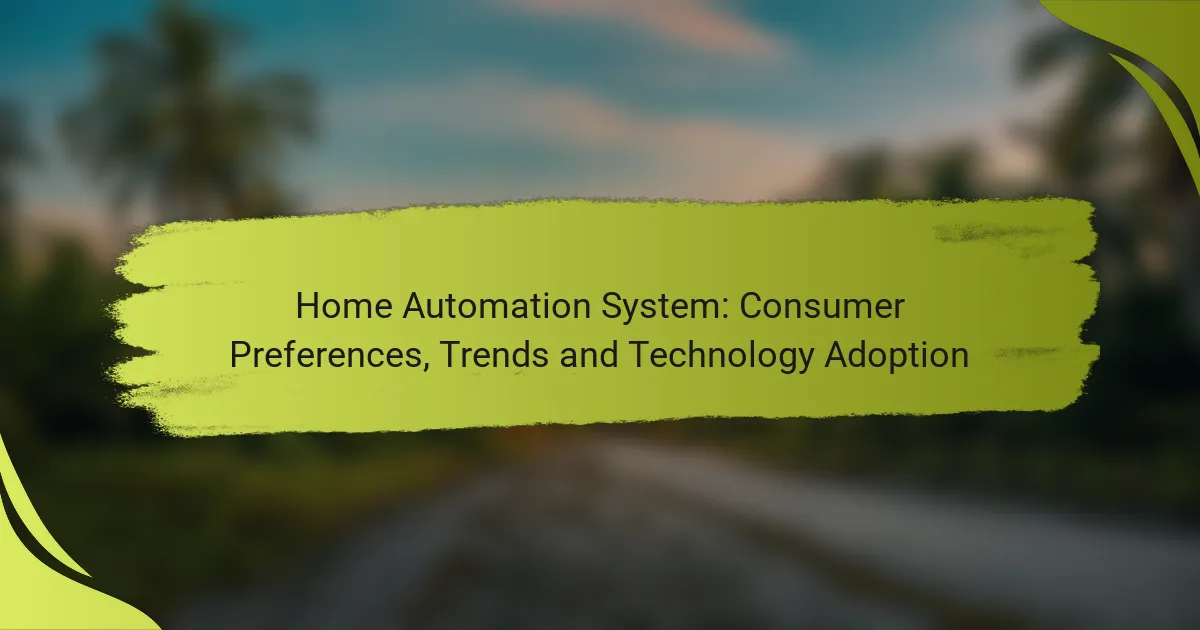The home automation market is rapidly evolving, with consumers in India increasingly adopting technologies that enhance convenience, security, and energy efficiency. Popular solutions such as smart lighting, security cameras, and voice-controlled assistants are shaping consumer preferences, which lean towards ease of use and customization. As trends continue to focus on advanced integration and streamlined home management, understanding these preferences is crucial for manufacturers and service providers to meet the growing demand.

What are the popular home automation solutions in India?
In India, popular home automation solutions include smart lighting systems, smart security cameras, smart thermostats, voice-controlled assistants, and home automation hubs. These technologies enhance convenience, security, and energy efficiency in residential settings.
Smart lighting systems
Smart lighting systems allow users to control their home lighting remotely via smartphone apps or voice commands. These systems often include features like dimming, color changes, and scheduling, which can help save energy and improve ambiance.
When selecting smart lighting, consider compatibility with existing fixtures and the ease of installation. Brands like Philips Hue and Wipro offer a range of options suitable for various budgets.
Smart security cameras
Smart security cameras provide real-time monitoring and alerts, enhancing home security. These cameras can be accessed remotely, allowing homeowners to check on their property from anywhere.
Look for features such as night vision, motion detection, and cloud storage. Popular choices in India include brands like Mi and Hikvision, which offer reliable performance at competitive prices.
Smart thermostats
Smart thermostats help regulate home temperatures efficiently by learning user preferences and adjusting settings automatically. This can lead to significant energy savings and increased comfort.
When choosing a smart thermostat, consider compatibility with your heating and cooling systems. Brands like Nest and Ecobee are well-regarded for their user-friendly interfaces and energy-saving capabilities.
Voice-controlled assistants
Voice-controlled assistants, such as Amazon Alexa and Google Assistant, enable hands-free operation of various smart devices. These assistants can manage tasks like adjusting lights, playing music, or providing weather updates through simple voice commands.
Ensure that the voice assistant you choose is compatible with your existing smart devices to maximize functionality. Integration with popular platforms can enhance the overall home automation experience.
Home automation hubs
Home automation hubs act as central controllers for various smart devices, allowing seamless communication between them. These hubs can simplify the management of multiple devices from different manufacturers.
When selecting a hub, consider its compatibility with your devices and the ease of setup. Popular options in India include Samsung SmartThings and Google Nest Hub, which support a wide range of smart home products.

What are the current trends in home automation technology?
Current trends in home automation technology focus on enhancing convenience, efficiency, and security through advanced integration and smart systems. Consumers are increasingly seeking solutions that streamline their daily lives while reducing energy consumption and improving overall home management.
Increased integration with IoT devices
The integration of Internet of Things (IoT) devices in home automation systems allows for seamless communication between various smart devices. This interconnectedness enables homeowners to control lighting, security cameras, thermostats, and appliances from a single interface, often via a smartphone app.
For effective integration, consider using devices that are compatible with popular platforms like Google Home or Amazon Alexa. This ensures that your devices can work together efficiently, enhancing the overall user experience.
Focus on energy efficiency
Energy efficiency is a significant trend in home automation, driven by rising energy costs and environmental concerns. Smart thermostats, for instance, can learn user habits and optimize heating and cooling schedules, potentially reducing energy bills by a notable percentage.
When selecting energy-efficient devices, look for those with ENERGY STAR ratings or similar certifications. These products not only save money but also contribute to a more sustainable lifestyle.
Rise of AI-driven automation
AI-driven automation is transforming home technology by enabling systems to learn and adapt to user preferences over time. This includes features like predictive maintenance alerts for appliances or personalized lighting based on daily routines.
To leverage AI in your home automation system, choose devices that offer machine learning capabilities. These devices can provide insights and recommendations, enhancing both convenience and efficiency in managing your home.

How do consumer preferences shape home automation choices?
Consumer preferences significantly influence the selection of home automation systems, as users prioritize ease of use, compatibility, and customization. Understanding these preferences helps manufacturers and service providers tailor their offerings to meet market demands.
Preference for user-friendly interfaces
User-friendly interfaces are crucial for the adoption of home automation systems. Consumers often seek intuitive controls that require minimal technical knowledge, allowing them to manage their devices effortlessly. A straightforward setup process and clear navigation can greatly enhance user satisfaction.
Examples of user-friendly features include voice control, mobile app integration, and simple touch interfaces. Systems that prioritize these aspects tend to attract a broader audience, particularly among less tech-savvy individuals.
Demand for compatibility with existing devices
Compatibility with existing devices is a key factor for consumers when choosing a home automation system. Many users prefer solutions that can seamlessly integrate with their current technology, such as smart speakers, security cameras, and lighting systems. This reduces the need for extensive upgrades and simplifies the overall user experience.
To ensure compatibility, consumers should look for systems that support widely used standards like Zigbee or Z-Wave. Checking for compatibility with popular brands can also help avoid potential integration issues.
Interest in customizable solutions
Customization is increasingly important to consumers seeking home automation systems. Users want the ability to tailor their setups to fit specific needs, whether that means adjusting settings for energy efficiency or creating personalized automation routines. This flexibility can enhance the overall functionality of the system.
When selecting a customizable solution, consumers should consider platforms that offer extensive options for automation scenarios, such as scheduling, geofencing, and conditional triggers. This allows for a more personalized experience that can adapt to changing lifestyles.

What are the key factors influencing technology adoption?
Key factors influencing technology adoption include cost, perceived security risks, and the availability of technical support. Understanding these elements can help consumers make informed decisions about implementing home automation systems.
Cost of installation
The cost of installation is a significant factor in the adoption of home automation systems. Consumers often weigh the upfront expenses against potential long-term savings on energy bills and increased property value. Installation costs can vary widely, typically ranging from a few hundred to several thousand dollars depending on the complexity of the system.
To manage costs effectively, consider starting with a basic setup and gradually adding features. This phased approach allows for budget flexibility and helps avoid overwhelming expenses at the outset.
Perceived security risks
Perceived security risks can deter consumers from adopting home automation technologies. Many individuals worry about potential hacking or unauthorized access to their personal data and home systems. These concerns are valid, as security breaches can lead to significant privacy violations.
To alleviate these fears, consumers should look for systems that offer strong encryption, regular software updates, and robust user authentication methods. Researching brands with a good reputation for security can also help build confidence in the technology.
Availability of technical support
The availability of technical support is crucial for consumers considering home automation systems. Many users may not have the technical expertise to troubleshoot issues independently, making responsive customer service essential. Systems that offer comprehensive support, including online resources and live assistance, tend to be more appealing.
Before purchasing, check the support options provided by the manufacturer. Look for warranties, user forums, and access to knowledgeable technicians to ensure help is readily available when needed.

What are the prerequisites for implementing a home automation system?
To implement a home automation system effectively, you need a reliable internet connection and a clear understanding of the compatibility of smart devices. These prerequisites ensure seamless integration and functionality of the various components within the system.
Stable internet connection
A stable internet connection is crucial for the smooth operation of a home automation system. Most smart devices rely on cloud services and remote access, which require consistent bandwidth and low latency. Aim for a broadband connection with speeds of at least 25 Mbps for optimal performance.
When setting up your home automation, consider the layout of your home and potential dead zones where the Wi-Fi signal may weaken. Using Wi-Fi extenders or a mesh network can help maintain coverage throughout your space, ensuring all devices remain connected.
Understanding of smart device compatibility
Understanding smart device compatibility is essential for a successful home automation setup. Not all devices work with every platform, so it’s important to check compatibility with your chosen hub or ecosystem, such as Google Home, Amazon Alexa, or Apple HomeKit.
Before purchasing devices, research their specifications and read user reviews to confirm they meet your needs. Consider creating a checklist of the devices you want to integrate, ensuring they support common communication protocols like Zigbee, Z-Wave, or Wi-Fi. This will help avoid frustration during installation and setup.

How to choose the right home automation system?
Choosing the right home automation system involves assessing your specific needs and budget. Consider the features that matter most to you, such as security, energy management, or convenience, and ensure the system fits within your financial plan.
Assessing budget and needs
Start by determining how much you are willing to spend on a home automation system. Prices can range from a few hundred to several thousand dollars, depending on the complexity and number of devices. Factor in installation costs if you opt for professional help.
Next, identify your primary needs. Are you looking to enhance security with smart locks and cameras, or do you want to improve energy efficiency with smart thermostats and lighting? Prioritize features based on your lifestyle and preferences to ensure you invest in the most beneficial technology.
Finally, consider the long-term costs associated with maintenance and potential upgrades. Some systems may require subscriptions for advanced features or cloud storage, so factor these ongoing expenses into your budget to avoid surprises later on.
